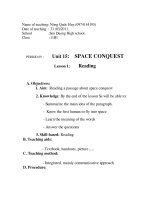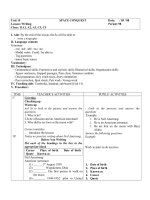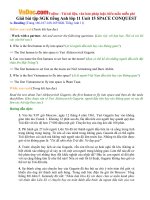- Trang chủ >>
- Văn Mẫu >>
- Văn Miêu Tả
Unit 15 Space conquest
Bạn đang xem bản rút gọn của tài liệu. Xem và tải ngay bản đầy đủ của tài liệu tại đây (2.52 MB, 31 trang )
<span class='text_page_counter'>(1)</span>Pham Tuan. Neil Armstrong. Yuri Gagarin.
<span class='text_page_counter'>(2)</span> Who is the first human to fly into space?. Yuri Gagarin.
<span class='text_page_counter'>(3)</span> Can you name the first human to set foot on the moon?. Buzz Aldrin. Neil Armstrong. Neil Armstrong.
<span class='text_page_counter'>(4)</span> Who is the first Vietnamese to fly into space?. Pham Tuan.
<span class='text_page_counter'>(5)</span> Pham Tuan and V. Gorbatko.
<span class='text_page_counter'>(6)</span> Unit 15 SPACE CONQUEST. Teacher: Phi Tien Hieu.
<span class='text_page_counter'>(7)</span>
<span class='text_page_counter'>(8)</span> 1. At 9.07 a.m. Moscow time on 12th April, 1961, Yuri Gagarin lifted off into space aboard the Vostok 1. Approximately 12 minutes later, the first human being was in orbit around the Earth at a speed of more than 17,000 miles per hour. His flight lasted 108 minutes. 2. The 27-year-old Soviet cosmonaut became the first person to eat and drink in weightlessness. From his window in space, Gagarin was able to view the earth in a way that no human beings had done before. The first words spoken from space were: “I see the Earth. It’s so beautiful!” 3. Before Gagarin’s historic flight, there were still enormous uncertainties. No one knew precisely what would happen to a human being in space. How would the body react to the extreme changes in temperature? How would the mind deal with the psychological tension? If there was a technical failure, Gagarin might never get back to the Earth. 4. The success of Gagarin’s flight attracted worldwide attention and made him a hero. In a telegram to Moscow, U.S. President John F. Kennedy wrote, “The people of the United States share with the people of the Soviet Union their satisfaction for the safe flight of the astronaut in man’s first venture into space. We congratulate you and the Soviet scientists and engineers who made this feat possible. ...” 5. Gagarin could have made another space flight if a tragic accident had not occurred. He died in a plane crash on a routine training flight in March 1968. After his death, his hometown of Gzhatsk was renamed Gagarin, and the Cosmonaut Training Centre at Star City, Russia, was given the name of this national hero..
<span class='text_page_counter'>(9)</span> Vocabularies Lift off (v): phóng lên, cất cánh, bay lên Orbit (n): quỹ đạo Cosmonaut = astronaut (n): nhà du hành vũ trụ Weightlessness = zero gravity (n): không trọng lực Uncertainty (n): sự không chắc chắn, điều không chắc chắn Congratulate (v): chúc mừng Congratulation (n): sự chúc mừng, sự khen ngợi Tragic accident: tai nan bi thảm Plane crash: tai nạn máy bay.
<span class='text_page_counter'>(10)</span> Lift off. Orbit. Weightlessness/ zero gravity. Cosmonaut/ astronaut. Plane crash. Congratulate.
<span class='text_page_counter'>(11)</span> Task 1: True or False statements 1961. F 1. Yuri Gagarin lifted off into space on 12th April 1963.. F 2. Y. Gagarin wasn’t was able to view the earth from Vostok 1. At 9.07 am Moscow time on 12th April, 1961, Yuri Gagarin lifted off intoGagarin space aboard theto Vostok 1. From his window in space, was able view the T 3. Before Gagarin’s historic flight, there were still earth in awayuncertainties. that no human beings had done before. enormous He died in a plane crash on a routine training T 4. U.S. President congratulated the people of the Soviet flight in March 1968.. Union and the Soviet scientists and engineers who made this feat possible.. F 5. Gagarin died because of tragic accident in March 1969 1968.
<span class='text_page_counter'>(12)</span> Task 2: Match the heading to the paragraphs. Paragraph 1. A. The tragic accident. Paragraph 2. B. The lift-off. Paragraph 3. C. Congratulations. Paragraph 4. D. A view on Earth. Paragraph 5. E. Uncertainties.
<span class='text_page_counter'>(13)</span> Task 3: Answer the questions 1. How old was Gagarin when he became the first human being in space? 2. How long was he in space? 3. What was the speed of his spacecraft in orbit around the Earth? 4. What were the first words spoken from space? 5. Why couldn’t Gagarin make a new space flight? 6. What was done after Gagarin’s death to honour this national hero?.
<span class='text_page_counter'>(14)</span>
<span class='text_page_counter'>(15)</span> 1. How old was Gagarin when he became the first human being in space? A. He was 27 years old. B. He was 33 years old. C. He was 34 years old. The 27-year-old Soviet cosmonaut became the first person to eat and drink in weightlessness. (Paragraph 2 line 1,2).
<span class='text_page_counter'>(16)</span> 2. How long was he in space?. A. He was in space for 17000 minutes. B. He was in space for 108 minutes C. He was in space for 100 minutes.. His flight lasted 108 minutes. (Paragraph 1 line 4).
<span class='text_page_counter'>(17)</span> 3. What was the speed of his spacecraft in orbit around the Earth? A. It was more than 107,000 miles per hour. B. It was more than 170,000 miles per hour. C. It was more than 17.000 miles per hour. Approximately 12 minutes later, the first human being was in orbit around the Earth at a speed of more than 17,000 miles per hour. (Paragraph 1 line 2,3,4).
<span class='text_page_counter'>(18)</span> 4. What were the first words spoken from space? A. “I understand.” B. “I see the Earth. It’s so beautiful!” C. “Everything is going well.”. The first words spoken from space were “I see the Earth. It’s so beautiful!” (Paragraph 2 line 4).
<span class='text_page_counter'>(19)</span> 5. Why couldn’t Gagarin make a new space flight?. A. Because he died in a plan crash on a routine training flight in March 1968. B. Because he was not enough strong to make a new space flight. C. Because the weather was bad, a new space fight was canceled. He died in a plane crash on a routine training flight in March 1968. (Paragraph 5 line 2, 3).
<span class='text_page_counter'>(20)</span> 6. What was done after Gagarin’s death to honour this national hero? A. After his death, his hometown of Gzhatsk was renamed Gagarin. B. After his death, he was honoured as a national hero. C. After his death, his hometown of Gzhatsk was renamed Gagarin, and the Cosmonaut Training Center at Star City, Russia, was given the name of this national hero. After his death, his hometown of Gzhatsk was renamed Gagarin, and the Cosmonaut Training Center at Star City, Russia, was given the name of this national hero. (Paragraph 5 line 3, 4, 5).
<span class='text_page_counter'>(21)</span>
<span class='text_page_counter'>(22)</span>









